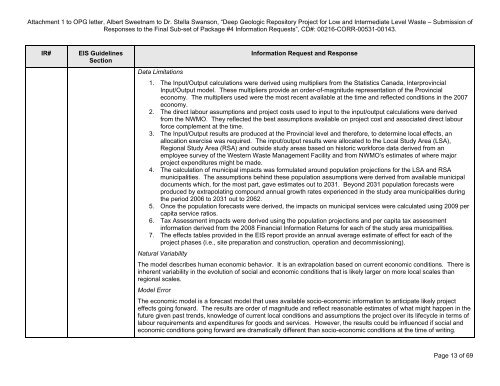Ontario Power Generation's Response to the Joint Review
Ontario Power Generation's Response to the Joint Review
Ontario Power Generation's Response to the Joint Review
Create successful ePaper yourself
Turn your PDF publications into a flip-book with our unique Google optimized e-Paper software.
Attachment 1 <strong>to</strong> OPG letter, Albert Sweetnam <strong>to</strong> Dr. Stella Swanson, “Deep Geologic Reposi<strong>to</strong>ry Project for Low and Intermediate Level Waste – Submission of<br />
<strong>Response</strong>s <strong>to</strong> <strong>the</strong> Final Sub-set of Package #4 Information Requests”, CD#: 00216-CORR-00531-00143.<br />
IR# EIS Guidelines<br />
Section<br />
Information Request and <strong>Response</strong><br />
Data Limitations<br />
1. The Input/Output calculations were derived using multipliers from <strong>the</strong> Statistics Canada, Interprovincial<br />
Input/Output model. These multipliers provide an order-of-magnitude representation of <strong>the</strong> Provincial<br />
economy. The multipliers used were <strong>the</strong> most recent available at <strong>the</strong> time and reflected conditions in <strong>the</strong> 2007<br />
economy.<br />
2. The direct labour assumptions and project costs used <strong>to</strong> input <strong>to</strong> <strong>the</strong> input/output calculations were derived<br />
from <strong>the</strong> NWMO. They reflected <strong>the</strong> best assumptions available on project cost and associated direct labour<br />
force complement at <strong>the</strong> time.<br />
3. The Input/Output results are produced at <strong>the</strong> Provincial level and <strong>the</strong>refore, <strong>to</strong> determine local effects, an<br />
allocation exercise was required. The input/output results were allocated <strong>to</strong> <strong>the</strong> Local Study Area (LSA),<br />
Regional Study Area (RSA) and outside study areas based on his<strong>to</strong>ric workforce data derived from an<br />
employee survey of <strong>the</strong> Western Waste Management Facility and from NWMO’s estimates of where major<br />
project expenditures might be made.<br />
4. The calculation of municipal impacts was formulated around population projections for <strong>the</strong> LSA and RSA<br />
municipalities. The assumptions behind <strong>the</strong>se population assumptions were derived from available municipal<br />
documents which, for <strong>the</strong> most part, gave estimates out <strong>to</strong> 2031. Beyond 2031 population forecasts were<br />
produced by extrapolating compound annual growth rates experienced in <strong>the</strong> study area municipalities during<br />
<strong>the</strong> period 2006 <strong>to</strong> 2031 out <strong>to</strong> 2062.<br />
5. Once <strong>the</strong> population forecasts were derived, <strong>the</strong> impacts on municipal services were calculated using 2009 per<br />
capita service ratios.<br />
6. Tax Assessment impacts were derived using <strong>the</strong> population projections and per capita tax assessment<br />
information derived from <strong>the</strong> 2008 Financial Information Returns for each of <strong>the</strong> study area municipalities.<br />
7. The effects tables provided in <strong>the</strong> EIS report provide an annual average estimate of effect for each of <strong>the</strong><br />
project phases (i.e., site preparation and construction, operation and decommissioning).<br />
Natural Variability<br />
The model describes human economic behavior. It is an extrapolation based on current economic conditions. There is<br />
inherent variability in <strong>the</strong> evolution of social and economic conditions that is likely larger on more local scales than<br />
regional scales.<br />
Model Error<br />
The economic model is a forecast model that uses available socio-economic information <strong>to</strong> anticipate likely project<br />
effects going forward. The results are order of magnitude and reflect reasonable estimates of what might happen in <strong>the</strong><br />
future given past trends, knowledge of current local conditions and assumptions <strong>the</strong> project over its lifecycle in terms of<br />
labour requirements and expenditures for goods and services. However, <strong>the</strong> results could be influenced if social and<br />
economic conditions going forward are dramatically different than socio-economic conditions at <strong>the</strong> time of writing.<br />
Page 13 of 69
















